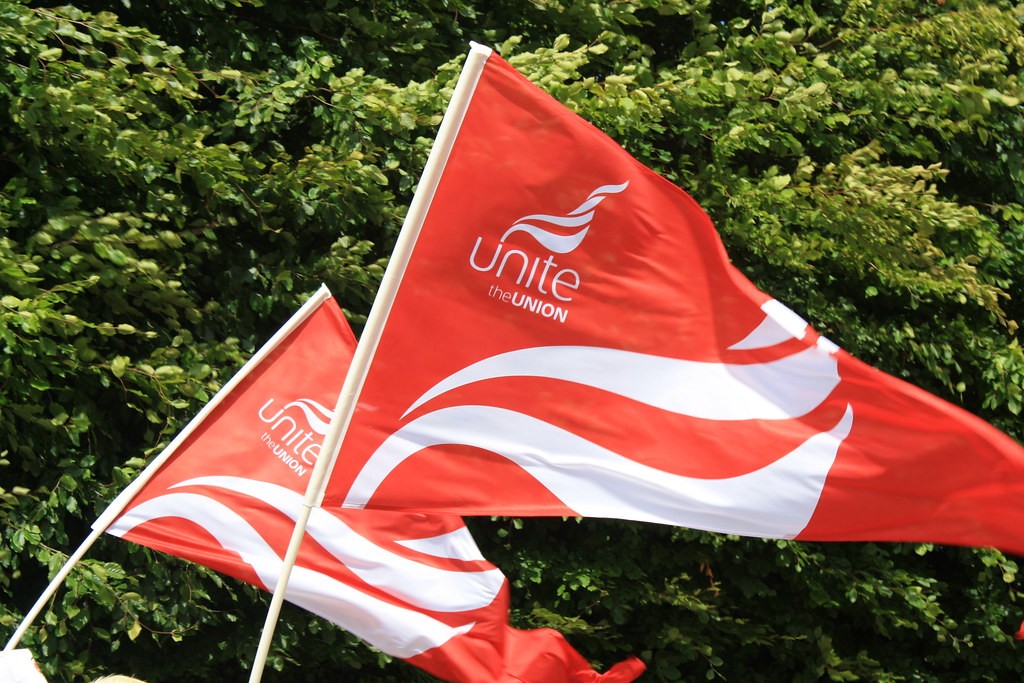At the Unite Policy Conference, Sharon Graham reiterated her commitment to enacting her manifesto and in doing so outlined how Unite is gearing up for struggle. Graham (echoing comments she made at the National Shop Stewards Network TUC Rally) spoke of Unite becoming a “Vanguard for change”. This is a crucial time for unions, as Graham noted, one in ten workers are under threat of Fire and Rehire, inflation is outstripping wages, and the spectre of automation looms large.
Consequently, Unite are readying themselves for a fight or rather multiple fights. There appears a much more strategic focus emanating from Unite than in recent years.. Essentially, Unite’s challenge is to grapple with work as it is now and not as it once was. Graham declared that “For most of our heritage unions, structures were put in place 100 years ago. We’ve moved on, we’re now dealing with multinational employers.” Graham’s subsequent question was “how do we bring them to the table?” Her answer is Combines – these are groups of shop-floor activists organised along industrial and sectoral lines for the purposes of action and negotiation.
Combines, a product of Unite’s Top Ten Employers’ strategy, are a significant development as they aim to pool expertise (which Unite is also trying to do by bringing their training back in-house) and would represent a substantial transformation of Unite’s structures. Unite is currently structured along regional lines, meaning that workers are organised by geography instead of employer (this can lead to discrepancies between the regions). The goal of this change would be to unify Unite’s strategy and agreements with the same employers across all regions. The logic being that companies have grown in scale and shape, so organised labour must do so as well. In the general secretary election, Graham was the only candidate who offered different solutions to the trade union movement’s popular problems instead of old ideas, and the speed at which Unite is trying to implement these should encourage its members. Indeed, Combines aim to be fighting fit and ready for action; thus, Graham highlighted the importance of providing them with resources such as forensic accountants and ensuring they have proper legal support. It was also announced that Combines will be transnational, working with Combines and unions in other countries to share tactics and coordinate action.
Further adding to the sense of a considered and comprehensive strategy was Graham’s statement that “Leverage will be more accessible to our members. We look at the companies, see where we can affect and frustrate them. Every company must have a leverage document ready to use”. Leverage is not one single approach, but a strategy of escalation that exists outside of typical industrial action and will vary from employer to employer, its purpose is to give Unite any advantage possible in negotiations.
Unite will hope that Leverage would give each of their branches a better chance of fighting back against bad employers. It also shows how Unite are adapting and applying creativity to their immediate circumstances. Anti-trade union legislation has made industrial action difficult (though disputes have never been as simple as just strikes) there is currently a gap in the law that allows for leverage tactics. While the law will promptly catch up with leverage, it should be noted that Unite have also pledged not to let the law stop them defending their members. Leverage is not a panacea to modern and effective industrial relations, but the arsenals of today’s trade unions are severely depleted.
Unite is also aiming to deploy brains as well as brawn, as is highlighted by the re-stating of the commitment to creating a Unite Bargaining Index to measure inflation, as the Retail Price Index (which is consistently higher than the Consumer Price Index) will no longer be published after 2030. If employers and wider society could be convinced to acknowledge this as a legitimate measure of inflation, Unite’s index has potential to be of considerable benefit to the rest of the trade union movement.
Graham also stated that Unite would support its workplace activists in legal disputes with the employer regardless of their chance of victory, she said “If we can’t show that we can protect our reps then we’ll have nothing left.” This would be a significant break from how Unite previously operated, where it often appeared they only supported cases where it was assumed they had a good chance of success.
If Unite can prove that a new model of trade unionism, one which is organised by sectors and with the shop-floor given more institutional support, works then the impact on wider trade union movement will be profound. The trade union movement is currently in danger of becoming ensconced in the public sector, Unite will have to take the lead if this is to change. Graham’s speech at the Unite Policy Conference showed that Unite has a clear strategy for industrial relations and, crucially, the focus and iron discipline that all aspiring vanguards need. If Combines work then they may just be the future.


